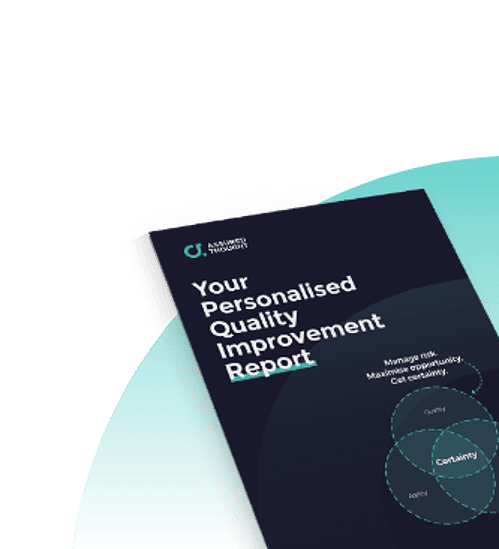Resource
2024 in review: Key takeaways from quality engineering and digital transformation for financial services
30 Dec 2024
Assured Thought’s 2024 blogs have all shared a common aim: to empower financial firms to elevate their digital initiatives. Over the past twelve months, we’ve explored the year’s industry trends, strategic approaches and regulatory shifts to help firms like yours navigate the complexities of quality engineering and digital transformation. As we close out 2024, it seems a good time to reflect on the year’s essential developments.
Here’s a recap of some of our most impactful blogs of the year, with a link to each so you can revisit them in full.
1. Evolving from quality assurance to quality engineering
One of the biggest themes this year was the shift from traditional quality assurance practices to a broader quality engineering approach. In ‘Navigating the shift from quality assurance to quality engineering in financial services’[Ed1] , we examined how embedding quality into the development lifecycle from day one can prevent costly issues down the road. By proactively engineering quality, financial firms can ensure digital transformation projects not only meet regulatory standards but also deliver strong performance and reliability.
2. Preparing for regulatory change: DORA’s impact
With the EU’s Digital Operational Resilience Act (DORA) becoming a critical consideration for UK financial firms operating in the EU, our ‘Preparing for DORA: A strategic imperative for UK financial firms’[Ed2] article explored the steps firms can take to enhance their risk resilience. Integrating compliance through quality engineering means firms can be confident they’re in alignment with regulatory requirements – while mitigating risks associated with digital disruptions. This post has been especially popular among firms seeking to adjust their operations ahead of DORA’s full implementation.
3. Emphasising speed and quality for C-suite strategy
Taking the time to ensure software is bug free doesn’t slow firms down in the long run – it helps them deliver greater quality at greater speed. In ‘Quality is faster: Digital transformation strategy for C-suite leaders’, we [Ed3] discussed how executives can use quality to increase delivery speed, a crucial factor in today’s competitive landscape. This post emphasised key principles for reducing time to market by increasing software reliability – ensuring digital transformation remains a strategic asset rather than a liability.
4. The power of blending consultancy with in-house teams
The challenges of digital transformation are often best tackled with a blend of in-house expertise and specialist consultancy support. In ‘The synergistic advantage of combining consultancy with in-house teams’[Ed4] , we highlighted how expert consultants bring specialised skills, methodologies and fresh perspectives to financial firms. This collaborative model allows in-house teams to scale up rapidly while benefitting from the consultants’ deep experience and insights – ensuring a seamless transfer of knowledge that strengthens internal capabilities.
5. Shift-left testing for improved outcomes
Throughout 2024, we championed the shift-left testing approach, a proactive strategy that involves testing earlier in the software development lifecycle. Revisiting this concept in ‘The value of shift-left testing for financial firms’[Ed5] , we showcased how this approach minimises defects, speeds up release cycles and boosts overall quality. For firms aiming to enhance the quality maturity of their digital products, shift-left testing is essential.
6. Driving quality through test automation in wealth and asset management
In October, we focused on the rising importance of test automation within wealth and asset management, where complex financial products and services demand rigorous testing. Our post ‘Test automation for high-quality software in wealth and asset management’[Ed6] emphasised how automation ensures consistency, reliability and efficiency, particularly in high-stakes financial environments. Firms leveraging automation can maintain top-notch quality standards even as they scale up their operations.
7. Integrating compliance and quality for Consumer Duty success
This year, the Financial Conduct Authority (FCA) introduced the Consumer Duty, setting high standards for customer-centricity and compliance. In ‘Ensuring compliance and quality with the new FCA Consumer Duty’[Ed7] , we explored how integrating compliance with quality engineering can give firms a competitive advantage. By making customer-centricity a priority, firms can meet regulatory requirements while enhancing user satisfaction – a true win-win.
Looking ahead: Building on 2024’s momentum
As we look towards 2025, Assured Thought is excited to continue guiding financial services firms through the evolving landscape of quality engineering and digital transformation.
This year’s insights have emphasised the importance of proactive quality engineering, compliance integration and strategic consultancy support – all of which are integral to achieving resilience and agility in digital initiatives.
We’re looking forward to bringing you even more strategies, thought leadership and actionable guidance to help your firm thrive in the year to come.
Thank you for following along in 2024, and here’s to a successful 2025!




